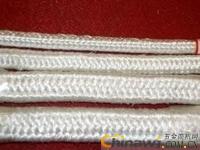Glass fiber packing introduction:
1. Glass fiber packing is usually woven from an alkali-free glass fiber square;
2. Glass fiber is the most ideal asbestos substitute in organic and inorganic fibers;
3. Excellent performance of glass fiber packing.
description:
The glass fiber packing is made of high-quality alkali-free glass fiber. It has excellent strength and high temperature resistance, so it does not shrink or expand during use, thus maintaining the original shape of the glass fiber packing and sealing. lasting. In order to meet the different requirements under different working conditions, Hebei New Innovative Sealing Materials Co., Ltd. also provides the following fiberglass products:
SUNWELL P801P -- PTFE fiberglass packing
SUNWELL P801S - Metal reinforced fiberglass packing
SUNWELL P801R -- Silicone core glass fiber packing
Glass fiber products are made of high-quality alkali-free glass fiber, which has many excellent properties: high strength, high temperature resistance, low density, low thermal conductivity, and insulation flame retardant. Performance characteristics: Application: Non-alkali glass fiber packing does not have any impregnation, and will not shrink and swell during use. Generally rectangular or circular cross section, generally used as a static seal for insulation and fire prevention of cabinets, furnaces, manholes, boxes and pipes, suitable for water, steam, air, oil and neutral chemical medium, impregnated with tetrafluoro emulsion The fiberglass packing is used as a pump valve seal. Temperature: 280 ° C (impregnated PTFE emulsion) 550 ° C PH value: 5~9.
Hebei Innovation Sealing Material Co., Ltd.
Mobile phone
phone
Contact: Business Manager

In chemical reactions reactants can change the chemical reaction rate (increase or decrease) without changing the chemical equilibrium, and its own quality and chemical properties of the chemical reaction did not change before and after the catalyst called (solid catalyst also called catalyst). According to statistics, about 90% of the industrial process using catalysts, such as chemical, petrochemical, biochemical, environmental protection and so on. [1] A wide range of catalysts, according to the state can be divided into liquid catalyst and solid catalyst; according to the reaction system is divided into homogeneous phase homogeneous catalyst and heterogeneous catalyst, homogeneous catalyst with acid, alkali, soluble transition metal compounds and peroxides catalyst. Catalysts occupy an extremely important position in the modern chemical industry. For example, three catalysts, namely, an iron catalyst for ammonia production, a vanadium catalyst for sulfuric acid production, ethylene polymerization, and three synthetic materials such as butadiene rubber are used .
Catalysts And Auxiliaries,Trimethylamine Hydrochloride,Tetrapropylammonium Bromide,Benzyltri N-Butylammonium Chloride
SHANDONG ZHISHANG CHEMICAL CO.LTD , http://www.zhishangchemical.com